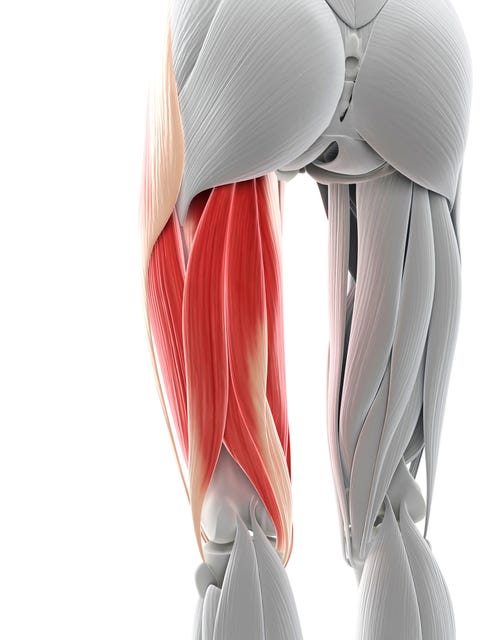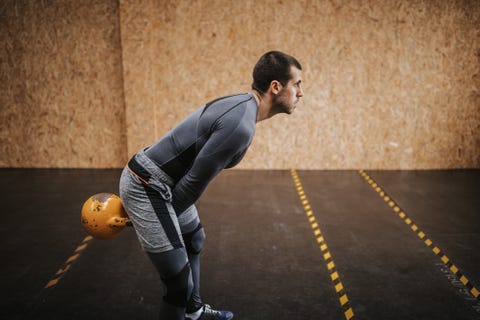There’s leg training. And then there’s hamstring training. And your hamstrings are often forgotten.
It happens to the best of us. You can easily go into the gym and crush a leg workout filled with squats and lunges, ending the session with your thighs on fire. But that doesn’t necessarily mean you smoked your hamstrings, the bands of muscle on the backs of your thighs.
They’re easy to forget, in much the same way that it’s easy to forget the importance of back training. You see your so-called “mirror muscles” like your quads, abs, and chest whenever you see your reflection. It’s simply not the same for back muscles, hamstrings and glutes.

Eric Rosati
But your hamstrings are a key muscle that you want to train. They’re one of the largest muscle groups in the body and can dictate a large amount of how successful you are with all your lower-body exercises and with metabolic flexibility, too. (Translation: Training your hamstrings will make you better at your classic squat exercises, and put you in position to burn through more calories, too.) Having a little extra hamstring meat can also make you a faster runner, and it’ll finish out the look of your legs in a pair of shorts or swim trunks, too.
That’s why it’s so important to do a little targeted hamstring training.
Your Quick Anatomy Lesson

SCIEPROGetty Images
Your hamstrings actually consist of three main muscles: the semimembranosus, the semitendinosus, and the biceps femoris. The biceps femoris includes two separate heads, a long head and a short head.
Both semis and the long head of the biceps femoris originate at the ischial tuberosity in the pelvis — and that’s important. That means they are involved in hip extension. What’s hip extension? That’s what happens when you stand up straight, and your thigh and torso straighten out. (The short head of the biceps femoris originates at the shaft of the femur, or thigh bone.)
This means that hip extension moves like glute bridges, and even the final act of standing up fully straight and pushing your pelvis forward during a squat, will recruit a lot of hamstring muscle (although these moves won’t recruit the short head of the biceps femoris). Don’t discount such moves when training hamstrings.
Meanwhile, all your hamstring muscles are active during knee flexion, the bending of your knee. Semimembranosus and semitendinosus insert at the tibia, while the biceps femoris insert at the head of the fibula. That placement means your lower leg internally rotates because of the semis, while it externally rotates because of the biceps femoris. This means you can create focus on different muscles by thinking about tibial rotation.
Your Hamstrings’ Opposing Muscle Group
The hamstrings are commonly known as the opposing muscle group to the quadriceps, but that doesn’t mean that when one of these muscles is working, the other group is relaxed. Hamstrings and quads work together; in order to stand, you must exhibit both hip extension (which includes plenty of quad contraction, with a little hamstrings action), and knee extension, which is hamstring-heavy.

bojanstoryGetty Images
This collaborative effort happens more often than you would think with all lower-body exercises. That means you can isolate your hamstrings, but it’s not the lone way to train them; when you’re doing squats and lunges, your hammies are getting plenty of work, too.
Your Hamstring Exercise Library
If you want to develop your hamstrings into the powerhouses their supposed to be, you need to use a variety of exercises. Here are 12 moves you can mix into your leg day training.
Deadlift
This may be the most well-known lower-body exercise out there, and it’s your hamstrings’ greatest tool for growth. The combination of heavy weight, multi-joint action, and hip extension is a recipe for quality muscular development.
How to: With feet shoulder-width apart and arms just outside of the legs, push the hips back as far as possible then bend the knee far enough to reach the bar. Keeping your core tight and your spine as tall as possible, pull the bar from the ground by standing tall and pulling the hips back to your standing position. Slowly lower the bar back to the ground, pushing your hips back as you do. Do 3 sets of 6 to 8 reps.
Romanian Deadlift
Romanian Deadlift is a great hip-hinging pattern that involves the hip extension of the deadlift while eliminating any extra knee action or focus. You maintain a soft bend in the knee, which places the emphasis of the move entirely on your posterior chain.
How to: Stand with feet shoulder-width apart, holding a loaded barbell at your hips with an overhand grip. Your knees should be slightly bent. Slowly push your hips all the way back with the weight gliding close to the front of your leg. Lower until you feel slight tension in your hamstrings, or until your torso is parallel to the ground, whichever comes first. Pull your hips forward and stand to return to the start. That’s 1 rep; do 3 sets of 6 to 8 reps.
Single-Leg Deadlift
The single-leg deadlift has all the advantages of the Romanian deadlift, except it recruits more posterior chain muscles to maintain stability. The gluteus medius jumps into the action to stabilize your femur at the hip joint while you focus your body to remain parallel to the ground.
How to: Stand with feet together and hold the weight in front of your thigh, arm extended and hands pronated. Bend left knee slightly as you bend forward from your hips, extending right leg to hip height behind you as you lower bar toward the floor. Rise up to the starting position and repeat. Switch sides to complete one full repetition. Do 3 sets of 6 to 8 reps.
Hex-Bar Deadlift
View this post on Instagram
A post shared by Eb Samuel (@ebenezersamuel23) on
The most translatable lower body move to everyday life that we have. The hex bar relieves the stress on the upper body by placing the hands in a neutral grip by your sides. This allows you to pack on more weight on, challenging your legs that much more.
How to: Lower your body down to grab the high handles of the hex bar with feet shoulder-width apart. Keeping your core tight and your shoulders above your hips, extend your knees and hips to stand up. Your upper body should remain as relaxed as possible while maintaining a firm grip on the bar. Squeeze your glutes at the top. Slowly lower the bar to the ground, pushing your butt back as you do. That’s 1 rep; do 3 sets of 6 to 8.
Glute Bridge
This is the move we’ve all seen in some fitness video at some point. It’s both simple enough that anyone can do it, and useful enough to pack muscle on anyone of any level.
How to: Lie flat on your back with feet flat on the ground and shoulder-width apart, legs bent to 90 degrees. Drive your heels into the ground, and lift your torso and upper legs into the air, extending your hips until your thighs and torso are in line with each other. Squeeze your glutes. Hold for a 2-second count. Return to the start. That’s 1 rep; do 3 sets of 10.
Barbell Hip Thrust
The barbell hip thrust is similar to the glute bridge, but it challenges hip extension by adding increased load. This will also attack your glutes.
How to: Sit on the ground, with your shoulder blades against a bench, feet flat on the floor, shoulder-width apart, knees bent. A barbell should be across the front of your hips. Hold the bar with your hands, stabilizing it. Squeeze your glutes to raise your hips off the ground and raise the bar off the floor. (Keep your chin tucked to maintain proper ribcage positioning. Pause when your thighs and torso are in line with each other, then return to the start. That’s 1 rep; do 3 sets of 8 to 10.
Slider/Swiss Ball Leg Curl
This is your traditional weight room machine leg curl, married to glute- and hamstring-challenging instability. The best part: It’ll rock your lower body with only bodyweight and gravity.
How to: Lie flat on your back with your feet flat on the ground and shoulder-width apart. Place the backs of your heels either on two sliders or a Swiss ball (if you use a Swiss ball, you’ll have to lift your thighs and lower back off the ground to get into position). This is the start. Tighten your core. Now pull your heels back as far as possible, bending at the knees primarily to do this. Pause, then push them back out so your legs are now straight. That’s 1 rep; do 3 sets of 10 to 12.
Kettlebell Swing
The basic kettlebell swing is one of the best ballistic moves you can add into a routine. It’s a movement that’s actually similar to a bodyweight broad jump, loading your hips and hamstrings, then forcing you to explode your pelvis and hips forward into extension. It’s a power-packed move that your hamstrings will feel for days, and it has multiple uses: It’ll get your metabolism up, and it trains your upper and mid-back more than you may think, too.
How to: Stand with an athletic stance, a kettlebell just in front of you. Grasp the kettlebell with both hands, then lift your hips enough to swing the bell back between your legs. Keep your core tight and aim to keep your back flat as you do this; don’t round your back. From that loaded position, explode your hips forward, squeezing your glutes and propelling your arms straight out in front of you, “swinging” the kettlebell to about eye level. Your torso should stay rigid once the kettlebell is at eye level. Let the kettlebell’s momentum take it back downward, then, as it descends toward you, push your hips back for another swing. That’s 1 rep; do 3 sets of 12 to 15.
Glute Ham Raise
The glute-ham raise machine is a go-to posterior chain move, somewhat mimicking the feel of a Romanian deadlift.
How to: Fix yourself into the glute-ham raise machine with the largest pad just above the knee. From the tall kneeling position, slowly lean forward with a controlled tall posture as far down as possible. From the end point, pull your body back up to the tall kneeling position using the hamstrings to curl you up. That is one rep.
Reverse Sled Pulls
In the same way driving a sled forward will hammer the quadriceps, dragging it backwards will call on the hamstrings. You’re also training the hamstrings in a real way, placing them in the same position they wind up in when they’re decelerating your lower body.
How to: Attach a TRX or strap to the sled and grab the TRX handles with both hands, chest facing the sled. Lean back, creating full tension in the strap while sitting back into an athletic stance. With arms extended in front, slowly drag the sled while walking backwards maintaining that athletic starting position. Do this move for distance; hit 3 sets of 25 to 30 feet.
Machine Leg Curl
The hamstring’s main job is to flex the knee. This machine places you in ideal position to do this.
How to: Set up in a leg curl machine and select a moderate amount of weight. Your calves should be against the leg piece of the machine. Flex at the knees to curl the leg piece back to your hamstrings; pause when it touches your hamstrings. Slowly return to the start. That’s 1 rep; do 3 sets of 12 to 15.
Cardio Row
The venerable cardio row does more than get your heart rate up; it’ll fire up your glutes and hamstrings, too. In fact, if you row with explosive power, there’s a good chance you’ll get off the rower with your hamstrings and glutes on fire. The movement of the cardio row, when done correctly, somewhat mimics a deadlift and barbell row, with both moves simply on a different plane.
How to: Set up on a cardio rower, and secure your feet. Bend at the knees and hips and hinge your torso forward slightly to grasp the handle. Holding it tightly with an overhand grip, straighten your knees and hips, hinge backward slightly, and pull the handle to your lower chest. Repeat the motion until you’ve covered the time or distance you want. A good starting point: Do 3 two-minute intervals of rowing, resting two minutes between each set.
Source: Read Full Article
